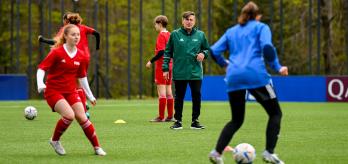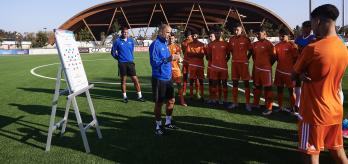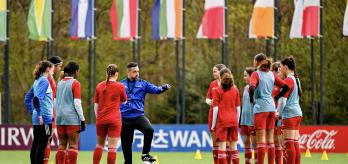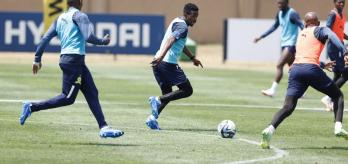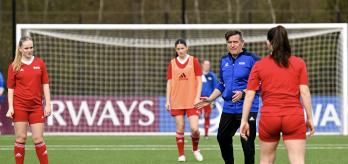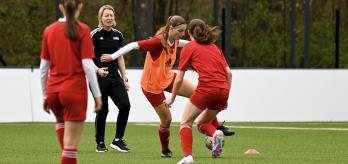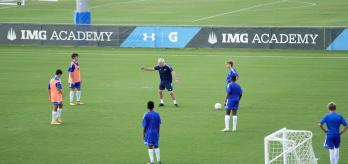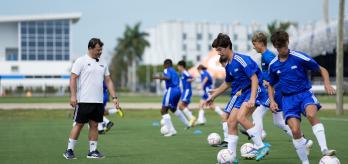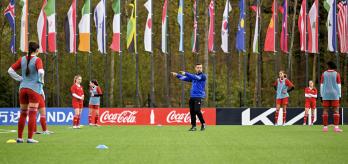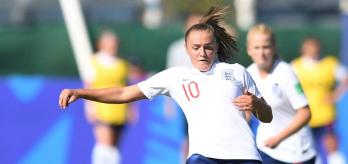Vertical passes open up avenues and allow a team to break through the opposition’s defensive lines and quickly transition from defence to attack. Diagonal passes, on the other hand, offer the versatility to exploit the space in a different way, stretching the opposition’s defence and creating dynamic angles for attacking players to capitalise on. Both types of passes are essential tools in any player’s arsenal, and the training drills presented in this article aim to sharpen players’ abilities to use them effectively.
In this session, FIFA Technical Expert Anouschka Bernhard delivers a series of vertical and diagonal passing exercises to a group of girls. The first exercise involves a passing circuit that is designed to get the players to pass and move diagonally. The second exercise ensures that the players play the diagonal passes into zones that team-mates are running into. The final two exercises allow the players to take the fundamental elements that they have learnt in the first two drills and apply them in a small-sided game and a diagonal passing game.
Session overview
Interview
Key coaching points
-
Well-timed and parallel movements are essential for playing successful diagonal passes.
-
Step or pull away from defenders to create diagonal passing lanes.
-
Horizontal passes can slow down attacks and make things too predictable.
-
Penetrate the defensive line by making vertical and diagonal runs on the blind side of defenders.
Part 1: Passing circuit
The first exercise aims to get the players accustomed to making parallel movements so that the diagonal passes are played efficiently.
-
Set up two identical rows of cones.
-
In each row, place a blue and yellow cone adjacent to each other and 2m apart.
-
Diagonal to the blue cone, place another blue cone about 2m away.
-
The two rows need to be about 5m apart.
-
Position a player at each of the yellow cones in each row.
-
One player must be positioned at the top of each row.
-
The player at the top of each row starts by dribbling into a position to open up a passing lane between the two blue cones.
-
The player at the yellow cone moves into the space so that they are parallel to the second blue cone.
-
As they arrive into the space, the first player plays a diagonal pass to them.
-
After receiving the pass, the player dribbles into a position to open up a passing lane between the next set of blue cones and passes to the next player who has moved from the yellow cone and into the space.
-
The sequence is repeated in each row.
-
Dribbling and running parallel to one another helps to facilitate diagonal passes between players.
-
Playing and receiving the ball while moving helps to improve the efficiency of the sequences and facilitate defence-splitting passes.
Part 2: Zone passing
The second exercise is designed to help players think about how parallel movements can facilitate well-timed diagonal passes.
-
Mark out a 36x30m playing area and divide it into nine equal zones.
-
Divide the group into two teams.
-
Distribute both teams across the playing area with two balls each.
-
Ideally, one player should occupy one zone at any given time.
-
Position three players from each team around the outside of the playing area.
-
Players pass to their team-mates in zones diagonal to them.
-
Players without the ball move into zones to make themselves available for a diagonal pass.
-
When a pass is played to the outside of the playing area, the receiving player enters the playing area, switching places with the player who played the pass.
-
Passes are only permitted between zones that are diagonal to each other.
-
Ask for diagonal passes to be played while on the move (also applies to the players around the outside of the playing area).
-
Emphasise the importance of passing accuracy and precision.
-
Players need to identify when to make parallel runs so that they can receive the ball in the diagonal zone with perfect timing.
Part 3: 6v6 plus 6 with four mini-goals
This small-sided game looks to take the fundamental elements learnt in the first two drills and put them into practice in a game scenario. By using neutral players and mini-goals, the players can now recognise diagonal passing routes more easily.
-
Mark out a 36x30m playing area with four mini-goals, two at each end.
-
Divide the group into three teams of six players (blue, orange and neutral).
-
The blue and orange teams play a 6v6 inside the playing area.
-
Four neutral players position themselves around the outside of the playing area – one on each side of the area – and two neutral players join the 6v6 inside the area.
-
The blue team attack one end and the orange team attack the other.
-
The team in possession should use the two neutral players inside the playing area.
-
The team in possession try to take advantage of their numerical superiority and score in one of the two mini-goals (the direction of play is predetermined).
-
The neutral players around the outside of the playing area provide additional vertical and diagonal passing options for the team in possession.
-
Avoid playing risky horizontal passes, as they are easy to predict and make it harder to progress the ball or maintain possession.
-
Continually involve the neutral players with diagonal and vertical passes.
-
Vertical movements off the ball and into space help the players in possession to pull defenders out of position.
Part 4: Diagonal passing game
The final exercise aims to bring together all the fundamental elements learnt in the previous exercises and apply them in a game scenario. Players must create diagonal passing angles and make vertical runs to facilitate the passes.
-
Mark out a 40x70m playing area with two full-size goals, one at each end.
-
Position a goalkeeper in the goal at one end of the playing area.
-
In the same half, mark out two horizontal lines across the full width of the playing area to create a defensive zone. One line should run along the edge of the penalty area, while the second line should be a further 10m infield.
-
Inside the defensive zone, position a defensive line of four blue defenders against four orange attackers.
-
Position two blue midfielders against four orange midfielders in the middle zone.
-
Position two orange defenders in front of the goal at the other end of the playing area.
-
Position two dummies in the middle of the playing area to act as obstacles.
-
Position two more dummies in front of the orange team’s goal to act as obstacles.
-
Position two mini-goals around 15m in front of the orange team’s goal, one to the left and one to the right.
-
Play a 10v6 game.
-
The ball starts with the two orange defenders, who must play a diagonal pass out of the backline.
-
The orange team try to progress the ball past the two blue midfielders and four dummies and into the final zone for an attempt at goal.
-
If the blue team win the ball, they can counter-attack towards the two mini-goals or the full-size goal at the opposite end.
-
If a goal is scored or the ball goes out of play, the exercise restarts with the two orange defenders.
-
Remove the dummies and play a 10v8.
-
Ask for diagonal passes to be played while on the move, as this is key to splitting defences open.
-
Avoid making risky and ineffective horizontal passes, as these will cause attacks to break down.
-
Emphasise passing accuracy and precision and maintain a high tempo.
















